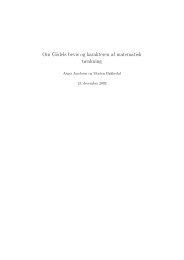Master Dissertation
Master Dissertation
Master Dissertation
You also want an ePaper? Increase the reach of your titles
YUMPU automatically turns print PDFs into web optimized ePapers that Google loves.
and for each a > 0,<br />
ρ(aδ)<br />
ρ(δ)<br />
= a2−n<br />
Thus in R 4 , ω = −2. Since the singular order is negative the splitting may<br />
be done by multiplication by the Θ-function (7.16). Hence the retarded<br />
part of the first term of (8.3) is<br />
R2(x1, x2) = −ie 2 : ψ(x1)γ µ ψ(x1)ψ(x2)γ ν ψ(x2) : ΘD0(x1 − x2)<br />
Further R ′ (x1, x2) is given by (8.2) by inspecting each term. By (5.12)<br />
T2(x1, x2)<br />
= R2(x1, x2) − R ′ (x1, x2)<br />
= −ie 2 : ψ(x1)γ µ ψ(x1)ψ(x2)γ ν ψ(x2) :<br />
<br />
ΘD0(x1 − x2) + D (+)<br />
<br />
0 (x2 − x1) .<br />
It is not the aim of this project to introduce Feynman propagators but the<br />
reader with knowledge of these might notice that the expression in<br />
brackets is actually a Feynman propagator describing the exchange of a<br />
photon between electrons.<br />
Figure 8.1: Photon exhange.<br />
8.2 The Adiabatic Limit<br />
In the introduction of the S-matrix we used test-functions g ∈ S(R 4 ),<br />
so-called switching functions. As the name infers they switch off<br />
long-range interaction to prevent infrared divergences 3 . Of course this is<br />
not a good model and we need to consider the so-called adiabatic limit<br />
g → 1 to take long-range interaction like the Coulomb-potential into<br />
account. We show how we may carry out the adiabatic limit. In practise it<br />
can me done by taking the so-called scaling limit.<br />
Let g0 ∈ S(R 4 ) be a fixed test-function such that g0(0) = 1. Then we let<br />
g(x) := g0(ɛx) and take the scaling limit, that is, we let ɛ → 0.<br />
Calculations are in practise usually done in momentum space. With this in<br />
mind we note that<br />
<br />
ˆg(k) =<br />
g(x)e −ix·k d 4 x =<br />
<br />
g0(ɛx)e −ik·x d 4 x = 1<br />
ɛ<br />
k<br />
ˆg0( ). (8.4)<br />
4 ɛ<br />
3 By infrared divergence we simply mean a divergence due to physical phenomena at<br />
very long distances or because of contributions from objects with very small energy<br />
69



